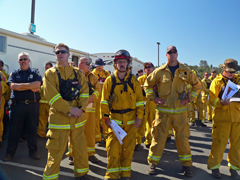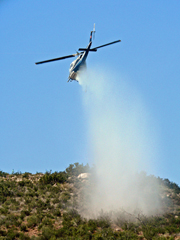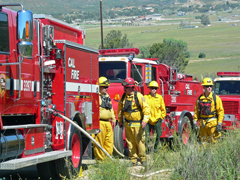By Miriam Raftery
 April 23, 2009 (Viejas Indian Reservation)—Preparing for fire season, fire
April 23, 2009 (Viejas Indian Reservation)—Preparing for fire season, fire
engine crews from more than 60 fire protection agencies donned full safety
gear and participated in structure protection drills, wildland hose lays, pumping
evolutions and other exercises. Aerial resources, including helicopters, practiced
coordinated fire attacks with ground crews under simulated fire conditions.
The eighth annual event was hosted this year at the Viejas Indian Reservation
east of Alpine on April 18, 21, 22 and 23.
San Diego County is home to 17 Native American tribes and 18 reservations
cover over
124,000 acres—more than any other County in the U.S. “ These lands are primarily
in the back country, where the wildfire threat is greatest,” Don Butz, Chief
of the Viejas Tribal Fire Department, told East County Magazine. “That’s
why it is so important to include the county’s tribes, especially the tribal
fire departments, in the planning and training stages of fire prevention and
management. And that is why Viejas is proud to host this year’s countywide
fire preparedness drills.”
Few San Diegans realize that firefighting is a long-standing tradition among
our region’s Indian tribal members. “Before tribal gaming, that’s how
many tribal members supported themselves,” Butz recalled. “On this reservation,
one half to one-third of the people have family members who are or were tribal
firefighters.” Nine of the 17 tribal agencies in our county have firefighters—and
they’ve fought fires as far away as Mendocino and Yosemite.
 Cities rely on tax revenues to fund firefighting, but recent budget cuts have
Cities rely on tax revenues to fund firefighting, but recent budget cuts have
hampered public safety efforts. So local tribes are stepping up to the
plate and pinch hitting. Several local tribes have pooled enterprise
revenues from Indian gaming, helping to buy helicopters, firefighting apparatus
and engine companies for neighboring communities including El Cajon and the
San Miguel Fire District, which protects unincorporated areas of the County
and more. Tribes have even helped to build fire stations and wells to
protect surrounding towns. “We’re talking millions of dollars,”
Butz observed, adding that tribal firefighters can provide protection from
more than wildfires in today’s era of terrorist threats. “Tribes are
stepping out of being just wildland firefighters.”
More than half of the calls that Viejas Fire Department responds to are off
the reservation. The tribe provides ambulance services as well as fire
protection through mutual aid agreements with neighboring Alpine. In addition,
Viejas has an automatic aid agreement with 11 other Heartland agencies including
coastal cities of Coronado, Imperial Beach and National City, the San
Miguel Fire Department (which covers unincorporated areas of the County), Lemon
Grove, La Mesa, El Cajon, and the Barona Reservation. Viejas Fire
Department has wildland and all risk divisions including a truck company, engine
company, two brush engines, two ambulances, and 25 fire suppression personnel—all
funded by tribal governments.
Tribal enterprise funds include not only Indian gaming revenues, but also
money from other business ventures owned by local tribes—including resorts,
hotels, a golf course, and the Viejas Outlet Center shopping mall.
 “By federal law, gaming revenues can only be used for five purposes,” Robert
“By federal law, gaming revenues can only be used for five purposes,” Robert
Scheid, public relations director for the Viejas Band of Kumeyaay Indians,
noted. “Four of those reasons are for the health and well-being of tribal
members, such as education and infrastructure. “ The fifth allowable use is The
fifth is contributions to charitable and civic organizations outside reservations
to benefit local communities and offset any potential negative impacts from
tribal gaming. Tribal efforts to provide fire protection to neighboring areas
have proven to be “a fantastic community resource,” Scheid concluded.
Battalion Chief Brad Rushing from the Alpine Fire Department addressed
more than 250 participants at Wednesday’s wildland fire training event. “We’re
holding a `bump and run drill’ this year,” he said. “It’s very fast and everyone’s
going to be timed…Strike leaders, keep your engines rolling!”
Firefighters were reminded to stay hydrated, watch for snakes, and keep radios
tuned to designated frequencies assigned to each incident. “Homeowners
in Alpine have been generous enough to let us use their homes,” Rushing added. “So
be careful not to damage driveways or landscaping.”
 Anabele Cornejo, assistant public affairs officer for Cleveland National Forest,
Anabele Cornejo, assistant public affairs officer for Cleveland National Forest,
praised Viejas for hosting the wildland fire drill. “Viejas allowing
us to stage here is huge, she said, adding that the multi-agency training helps
firefighters refresh their skills and assures that all departments and agencies
work together.
La Mesa sent an engine company and a division chief to participate. “It’s
fantastic,” Sonny Sughera of La Mesa’s Fire Department said. “The City
engines go out on fires just as much as Cal-Fire, so this is a good refresher.”
A helicopter scooped water and dropped it on a rugged hillside, where a crew
trekked uphill to practice laying hoses. Asked what’s most important
for crews to learn in the hose lay exercise Cal-Fire Captain Alex Davenport
replied, “To put in a good wet line. You don’t want fire to come in and J-hook
‘em.”
The inter-agency fire drills aren’t all that’s new on the Viejas reservation.
 “We recently started a program for young adults, ages 14 to 21, providing
“We recently started a program for young adults, ages 14 to 21, providing
opportunities to explore the career of a firefighter,” Chief Butz told East County Magazine. Students
learn firefighting skills as well as administration, fire prevention, and investigation. “We
just had an academy. Youths went through six days of training, 50 to 60 hours.
When they are done, they will have 100 hours and this will be a real asset
to the community.”
Students will ride on fire trucks, though their scope will be limited.
In addition, they will participate in responsibilities including parades, traffic
details, and planting fire-safe demonstration gardens in communities.
“We’ll be doing another recruitment, and it’s open to all community members,”
Butz said. Participants can get professional certifications and work
experience. Although program participants are volunteers, participants
can receive professional certifications and work experience. “If they
stick with it, 80% of kids will wind up working for a fire department in some
capacity,” Butz predicted.
With fire season fast approaching, tribal efforts to enhance our region’s
firefighting manpower, skills and equipment may well be San Diego County’s
strongest secret weapon for battling future firestorms.











Recent comments